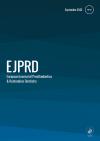European Journal of Prosthodontics and Restorative Dentistry
Evaluating the Bond Strength of a Polymer Infiltrated Ceramic Network to Zirconia Using the Crossbeam Push-Off Method
Abstract
Porcelains and glass-ceramics have been used to produce CAD-milled veneers and crowns for zirconia copings and implant-abutments. This study evaluated the bondstrength of a polymer-infiltrated-ceramic-network to zirconia using two adhesive cement systems: Panavia 21 and Multilink Automix. Lithium disilicate and feldspathic porcelain were also tested as reference CAD-On materials. Long beams (3x6x40 mm3) of zirconia and short beams (3x6x15 mm3) of the CAD-On materials were prepared. Zirconia and each CAD-On material were bonded in a crossbeam arrangement and subjected to a modified tensile bond-strength test. Half of the samples in each group (n=10) were tested 5 days after bonding (baseline) and the remaining (n=10) underwent aging (50,000 thermocycles at 5°C and 55°C) prior to bond-strength testing. The effects of material, cement, and aging on the tensile bond-strength were tested using a three-way
ANOVA. The reference lithium disilicate/Multilink system showed no significant differences in bond strength compared to polymer-infiltrated-ceramic-network and porcelain. The long-term retention of polymer-infiltrated-ceramic-network was not statistically different compared to the baseline values and the two reference materials. With comparable bond strength between all materials, polymer-infiltrated-ceramic-network is the favorable choice for CAD-On to zirconia copings and implant-abutments due to its superior resistance to fatigue fracture relative to porcelain.
Keywords
Glass-Ceramic
Feldspathic Ceramic
Zirconia
Adhesion
Resin Cement
Polymer Infiltrated Ceramic
Authors
Nadav Bashary, Marina R. Kaizer, Abeer Tashkandi, Yuwei Fan, Mutlu Özcan, Nadin Al Haj Husain, Yu Zhang
Articles from this issue
 Free Access
Free Access No Access
No Access Full Access
Full Access


